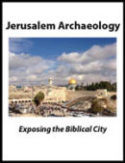During excavations at the Givati Parking Lot in Jerusalem, in the area between the Ophel and the City of David, archaeologists discovered fascinating channels that they believe were related to the Temple or royal palace during the reigns of Joash and Amaziah in the ninth century BCE. There is just one problem: They have no idea what they were used for.

A Mystery in Jerusalem
Located in the heart of ancient Jerusalem, the channels are unique within the archaeology of Israel. Consisting of two separate installations, 32 feet apart, the channels are cut into the bedrock of the hillside. The first installation consists of nine channels, smoothed on the inside. The second installation includes at least five channels that were related in some way to an industrial process carried out in the first installation
As the channels were found near the area of the Temple and the city’s royal administrative quarter, excavators from the Israel Antiquities Authority (IAA) and Tel Aviv University propose the installations may have been used for industries related to one or both institutions. Currently, the team’s best guess is that they may have been used to soak products or materials, as the channels show no signs of having carried or transported liquid from one area to another.
“The production of linen, for example, requires soaking the flax for a long time to soften it,” said Yiftah Shalev, a senior researcher with the IAA and co-director of the excavation. “Another possibility is that the channels held dates that were left out to be heated by the sun to produce silan (date honey), like similarly shaped installations discovered in distant places such as Oman, Bahrain, and Iran.”
Despite these suggestions, the team still has little evidence to prove their theories. “We looked at the [first] installation and realized that we had stumbled on something unique, but since we had never seen a structure like this in Israel, we didn’t know how to interpret it. Even its date was unclear,” continued Shalev. “We brought a number of experts to the site to see if there were any residues in the soil or rock that are not visible with the naked eye, and to help us understand what flowed or stood in the channels. We wanted to check whether there were any organic remains or traces of blood, so we even recruited the help of the police forensic unit and its research colleagues around the world but, so far, to no avail.”

Yuval Gadot (right) and Yiftah Shalev examine the mysterious channels. Courtesy Asaf Perry, City of David.
The mystery only grew deeper when a second installation was found to the south. “This [second] installation consists of at least five channels that transport liquids,” said Yuval Gadot of Tel Aviv University and the excavation’s other co-director. “Despite some differences in the way the channels were hewn and designed, it is evident that the second installation is very similar to the first. This time, we also managed to date when the facility fell out of use, at the end of the ninth century BCE, during the days of the biblical kings of Judah, Joash and Amaziah. We assume that the two installations may have been used in unison.”
According to Gadot, “This is an era when we know that Jerusalem covered an area that included the City of David and the Temple Mount, which served as the heart of Jerusalem. The central location of the channels near the city’s most prominent areas indicates that the product made using them was connected to the economy of the Temple or palace. One should note that ritual activity includes bringing agricultural animal and plant produce to the Temple; Many times, Temple visitors would bring back products that carried the sanctity of the place.”
Read more in Bible History Daily:
All-Access members, read more in the BAS Library:
Jerusalem and the Holy Land(fill)
Jerusalem in David and Solomon’s Time
Not a BAS Library or All-Access Member yet? Join today.The post Mysterious Jerusalem Channels Confound Archaeologists appeared first on Biblical Archaeology Society.




0 Commentaires